Transportation in the San Francisco Bay Area

Transportation in the San Francisco Bay Area is reliant on a complex multimodal infrastructure consisting of roads, bridges, highways, rail, tunnels, airports, and bike and pedestrian paths. The development, maintenance, and operation of these different modes of transportation are overseen by various agencies, including the California Department of Transportation (Caltrans), the Association of Bay Area Governments, San Francisco Municipal Transportation Agency, and the Metropolitan Transportation Commission. These and other organizations collectively manage several interstate highways and state routes, two subway networks, two commuter rail agencies, eight trans-bay bridges, a ferry, local bus service, three international airports, and an extensive network of roads, tunnels, and bike paths. A 2011 Brookings Institution study ranked the San Francisco MSA and the San Jose MSA sixteenth[1] and second,[2] respectively, on transit coverage to job access. Another nationwide study, conducted by the University of Minnesota in 2014, ranked the San Francisco MSA second and San Jose MSA tenth.[3] Despite this, the San Francisco Bay Area remains the second most traffic-congested region in the country with a declining per capita use of public transit.
Airports

The following airports are served by commercial airlines. In addition there are many general aviation airports in the region.
- San Francisco International Airport (SFO)
- The busiest in the region, and a major international hub airport in California second only to LAX (Los Angeles). Hub to United Airlines and Virgin America.
- Oakland International Airport (OAK)
- The second-busiest airport in the region and a major base airport for Southwest Airlines. Oakland International Airport is the oldest of the Bay Area's civilian airports still in use. The site was chosen due to its superior weather conditions for aircraft operations.
- Mineta San Jose International Airport (SJC)
- The third-busiest and fastest-growing airport in the Bay Area.[4]
- Charles M. Schulz - Sonoma County Airport (STS)
- A minor airport in Santa Rosa, it is served by two commercial airlines, Horizon Air and Allegiant Air.
Airport shuttle service
Airport shuttle buses and vans provide services from the three major San Francisco Bay Area airports, namely San Francisco International Airport (SFO), Oakland International Airport (OAK), and San Jose International Airport (SJC) — Flat Rate Airport Taxi Cab and Car Service; BayPorter Express Airport Shuttle; Marin Airporter; Marin County Airport Shuttle; Monterey Airport Shuttle; Non Stop Airport Shuttle; Sonoma County Airport Express; SuperShuttle; and Cook Limousine Services.
Public transportation


Public transportation in the San Francisco Bay Area is quite extensive, including one heavy rail/commuter rail system, one commuter rail line, two light rail systems, Amtrak inter-city rail service, and four major overlapping bus agencies, in addition to dozens of smaller ones. In addition to rail and bus systems, there are multiple public and private ferry services, such as Golden Gate Ferry, which are being expanded by the San Francisco Bay Water Transit Authority. Most of the larger agencies accept the Clipper Card, a reloadable contactless smart card, as a universal electronic payment system.
An extensive rail infrastructure that provides a mix of services exists within the nine Bay Area counties. Bay Area Rapid Transit, commonly known as BART, provides subway service in San Francisco and parts of Oakland and Berkeley, and commuter rail service to Contra Costa County, Alameda County, and San Mateo County. An expansion that is currently under construction will build an additional station in Alameda County and bring BART south into Santa Clara County by 2016. Caltrain, which runs on the right-of-way of the historic Southern Pacific Railroad, provides commuter rail service on the San Francisco Peninsula, linking the cities of San Francisco, San Jose, Gilroy, and numerous peninsula cities in between. The Millbrae Intermodal Terminal provides transfers between Caltrain and BART. The Altamont Commuter Express, commonly known as ACE, also provides commuter rail service, but from the Central Valley into Silicon Valley, terminating in the San Jose Diridon Station.
In addition, Amtrak has a presence throughout the Bay Area. Stations in Martinez and Emeryville feature Coast Starlight and California Zephyr service. The Capitol Corridor connects Bay Area cities to Sacramento, and features BART transfer stations at Richmond and the Oakland Coliseum. The Bay Area also has two light rail systems: one run by San Francisco Municipal Railway called Muni Metro, which operates within the city of San Francisco, and the other run by the Santa Clara Valley Transportation Authority, which operates within Santa Clara County.
A series of overlapping bus agencies provide additional public transit coverage to Bay Area regions both served and not served by rail transit. The four largest agencies, Muni, AC Transit, SamTrans, and VTA operate within the City of San Francisco, East Bay, the Peninsula, and South Bay respectively, although their service areas generally overlap with neighboring agencies and numerous smaller agencies. All of these agencies also provide limited night bus service, which are intended to "shadow" the rail routes that are closed during the nighttime hours for maintenance. In addition, the four bus agencies are each independently pursuing constructing bus rapid transit systems by developing separated right-of-ways and traffic signaling on busy corridors, including on Geary and Van Ness for Muni, El Camino Real for SamTrans and VTA, and International Boulevard for AC Transit.
Although BART and certain bus agencies provide travel over (or under) the San Francisco bay, Golden Gate Transit also runs the Golden Gate Ferry, which along with private operators Blue & Gold Fleet and Red & White Fleet provide ferry service across the bay. The ferry, along with all the major train and bus operators, allow bicycles onto their systems with no additional charge. In addition, Bay Area residents may rent bicycles from the Bay Area Bike Share in certain parts of San Francisco, San Mateo, and Santa Clara counties.
Until 1971 the Southern Pacific Railroad operated from its Third and Townsend Depot commuter trains to San Jose and long distance trains to Los Angeles.
Metro/Heavy Rail
| Agency Name | Train Example | Service Area | Daily Ridership | Clipper? | Routes | Stations | Track Length | Track Gauge | Mass Transit Connections |
|---|---|---|---|---|---|---|---|---|---|
| BART | 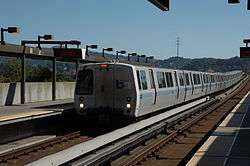 |
San Francisco, Alameda and Contra Costa counties Parts of: San Mateo County Planned: Santa Clara County |
455,400[5] | Yes | 5 | 44 (16 subway, 28 surface) 5 under construction (surface) |
104 mi (167 km) | 5 ft 6 in (1,676 mm) (Indian gauge) |
Amtrak, Caltrain, Muni Metro, VTA Light Rail (under construction) |
Commuter Rail
| Agency Name | Train Example | Service Area | Daily Ridership | Clipper? | Routes | Stations | Track Length | Track Gauge | Mass Transit Connections |
|---|---|---|---|---|---|---|---|---|---|
| ACE |  |
San Joaquin, Alameda and Santa Clara counties | 4,900[5] | No | 1 | 10 (10 surface) | 86 mi (138 km) | 4 ft 8 1⁄2 in (1,435 mm) (standard gauge) |
Amtrak, Caltrain, VTA Light Rail |
| Caltrain |  |
San Francisco, San Mateo and Santa Clara counties | 58,200[5] | Yes | 1 | 32 (32 surface) 1 planned (subway) |
77.4 mi (124.6 km) | 4 ft 8 1⁄2 in (1,435 mm) (standard gauge) |
ACE, Amtrak, BART, Muni Metro, VTA Light Rail |
| Capitol Corridor |  |
Santa Clara, Alameda County, Contra Costa, Yolo, Sacramento, and Placer counties | 5,000[5] | No | 1 | 17 (17 surface) | 168 mi (270 km) | 4 ft 8 1⁄2 in (1,435 mm) (standard gauge) |
ACE, Amtrak, BART, Caltrain, VTA Light Rail |
| eBART under construction |
 |
Eastern Contra Costa County | – | Yes | 1 | 3 | 10 mi (16 km) | 4 ft 8 1⁄2 in (1,435 mm) (standard gauge) |
BART |
| SMART under construction |
 |
Marin and Sonoma counties | — | Yes | 1 | 9 under construction (surface) 5 planned (surface) |
38 mi (61 km) | 4 ft 8 1⁄2 in (1,435 mm) (standard gauge) |
Ferry (planned) |
Light rail
| Agency Name | Train Example | Service Area | Daily Ridership | Clipper? | Routes | Stations | Track Length | Track Gauge | Mass Transit Connections |
|---|---|---|---|---|---|---|---|---|---|
| Muni Metro |  |
San Francisco | 157,400[5] | Yes | 6 | 33 (9 subway, 24 surface) 4 under construction 87 additional surface stops |
34.6 mi (55.7 km) | 4 ft 8 1⁄2 in (1,435 mm) (standard gauge) |
BART, Caltrain, and Ferries |
| San Francisco Cable Car |  |
San Francisco | 16,100[5] | Yes | 3 | 52 | 5.1 mi (8.2 km) | 3 ft 6 in (1,067 mm) | BART, Muni Metro |
| San Francisco Heritage Streetcars | |
Market Street Railway, Embarcadero |
23,208 (F)[6] N/A (E) |
Yes | 2 | 32 (F) | 6 mi (9.7 km) | 4 ft 8 1⁄2 in (1,435 mm) (standard gauge) |
BART, Muni Metro, Ferries, and Caltrain |
| VTA Light Rail | .jpg) |
Santa Clara County | 30,800[5] | Yes | 3 | 62 (62 surface) | 42.2 mi (67.9 km) | 4 ft 8 1⁄2 in (1,435 mm) (standard gauge) |
ACE, Amtrak, BART(under construction), Caltrain |
People Movers
| System | Train Example | Service Area | Daily Ridership | Clipper? | Routes | Stations | Track Length | Mass Transit Connections |
|---|---|---|---|---|---|---|---|---|
| AirTrain |  |
San Francisco International Airport | n/a | 2 | 9 | 6 mi (9.7 km) | BART | |
| Coliseum–Oakland International Airport line |  |
Oakland International Airport | 2,800[5] | Yes | 1 | 2 | 3.2 mi (5.1 km) | Amtrak, BART |
Bus services
The Transbay Terminal serves as the terminus for long-range bus service (such as Greyhound and BoltBus[7]) and as a hub for regional bus systems AC Transit (Alameda & Contra Costa counties), WestCAT, SamTrans (San Mateo County), and Golden Gate Transit (Marin and Sonoma Counties).[8]
Megabus recently relaunched intercity bus service in California and Nevada.[9] San Francisco riders can choose from three routes (SF-San Jose-LA, SF-Oakland-LA, & SF-Sacramento-Reno). The San Francisco stop is located in front of the Caltrain Station. Other intercity bus services include California Shuttle Bus, Hoang Transportation, and USAsia.[10]
Major bus agencies
| Agency Name | Bus Example | Service Area | Daily Ridership | Clipper? | Number of Routes | Mass Transit Connections | ||||
|---|---|---|---|---|---|---|---|---|---|---|
| Local/ Basic |
Rapid/ Limited |
Express/ Commuter |
Shuttle | All-Nighter | ||||||
| AC Transit | 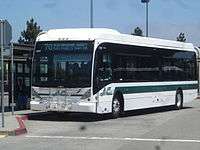 |
Entire: Inner East Bay (western Alameda County and western Contra Costa County) Parts of: San Francisco, San Mateo, and Santa Clara counties |
215,800[5] | Yes | 68 | 4 | 29 | None | 6 | Amtrak, BART, Caltrain, ferries and VTA Light Rail |
| SamTrans |  |
Entire: San Mateo County Parts of: San Francisco and Santa Clara County |
41,400[5] | Yes | 30 | None | 1 | None | 2 | BART, Caltrain, and Muni Metro |
| Muni |  |
Entire: San Francisco Parts of: Marin and San Mateo counties |
494,400[5] | Yes | 42 | 5 | 16 | None | 10 | BART, Caltrain, ferries and Muni Metro |
| VTA |  |
Entire: Santa Clara County Parts of: Alameda and San Mateo counties |
104,700[5] | Yes | 54 | 5 | 12 | 12 | 1 | Amtrak, BART, Caltrain and VTA Light Rail |
| Note: Some routes that operate as one route type may also be listed as another type (e.g. select daytime Muni services also operate as All-Nighter routes) | ||||||||||
Minor bus agencies
| Agency Name | Bus Example | Service Area | Daily Ridership | Clipper? | Number of Routes | Mass Transit Connections | |||||
|---|---|---|---|---|---|---|---|---|---|---|---|
| Local/ Basic |
Rapid/ Limited |
Express/ Commuter |
Shuttle | All-Nighter | |||||||
| County Connection | 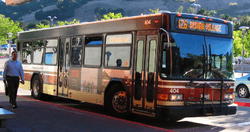 |
Parts of: Contra Costa County (Concord, Martinez, Orinda, San Ramon, Walnut Creek) and Alameda County (Dublin/Pleasanton BART) | 11,627[11] | Yes | 35 | None | 7 | 2 | None | Amtrak and BART | |
| Dumbarton Express | Parts of: Alameda County (Fremont, Newark, Union City) and Santa Clara County (Palo Alto) | — | No | None | None | 3 | Yes | None | Connects BART and Caltrain | ||
| Emery Go Round | |
Parts of: Emeryville (MacArthur BART) | — | No (service is free) | 6 | None | None | None | None | Connects BART and Amtrak | |
| Fairfield and Suisun Transit | Parts of: Sacramento city, and Contra Costa, Yolo, and Solano counties | — | Yes | 10 | None | 4 | None | None | Amtrak and BART | ||
| Golden Gate Transit |  |
Parts of: San Francisco, and Contra Costa County (El Cerrito, Richmond), Marin County, and Sonoma County (Santa Rosa) | 22,106[12] | Yes | 20 | 1 | 20 | None | None | BART and Muni Metro | |
| Healdsburg Transit | Entire: Healdsburg | — | No | 1 | None | None | 1 | None | |||
| Marin Transit | 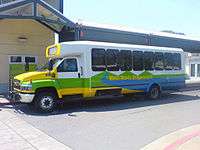 |
Entire: Marin County | — | Yes | 14 | None | None | 7 | None | ||
| Petaluma Transit |  |
Entire: Petaluma | — | Yes | 5 | None | None | None | None | ||
| RidePal | Parts of: Alameda, Santa Clara, Contra Costa, San Francisco counties | — | Yes - ID only | 25 | None | 25 | 0 | None | BART and Caltrain | ||
| San Benito County Transit | Entire: San Benito County Parts of: Santa Clara County (Gilroy) |
— | No | 6 | 2 | None | None | None | Caltrain | ||
| San Leandro LINKS | Entire: San Leandro, California | — | No/Free | 1 | None | None | None | None | BART | ||
| Santa Cruz Metro | Entire: Santa Cruz County Parts of: Santa Clara County (San Jose) |
— | No | 30 | 5 | 1 | None | None | Amtrak/VTA light rail/Caltrain/ACE at Diridon Station | ||
| Santa Rosa CityBus | 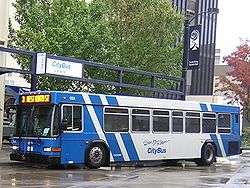 |
Entire: Santa Rosa | — | Yes | 18 | None | None | None | None | ||
| SolTrans | Parts of: San Francisco, and Contra Costa and Solano counties | — | Yes | 11 | None | 6 | None | None | BART | ||
| Sonoma County Transit |  |
Entire: Sonoma County Parts of: Marin County (San Rafael) |
— | Yes | 20 | None | 6 | None | None | ||
| Stanford Marguerite | 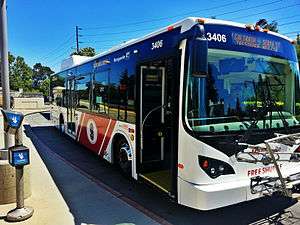 |
Entire: Stanford University campus Parts of: Santa Clara County (Palo Alto and Mountain View), San Mateo County (Menlo Park), and Alameda County (Fremont and Union City) |
5,300 | No/Free | 7 | 3 | None | 9 | 3 | BART and Caltrain | |
| Tri Delta Transit | Parts of: Alameda County (Dublin/Pleasanton BART Station), Contra Costa County (Antioch, Brentwood, Concord, Martinez, Pittsburg), and San Joaquin County (Mountain House) | — | Yes | 13 | None | 7 | 1 | None | BART and Amtrak | ||
| Union City Transit | Entire: Union City | — | No | 5 | None | None | None | None | BART | ||
| Vacaville City Coach | Entire: Vacaville | — | Yes | 4 | None | None | None | None | |||
| VINE |  |
Entire: Napa County Parts of: Solano County (Vallejo) and Sonoma County (Santa Rosa) |
— | Yes | 12 | None | 2 | 4 | None | BART | |
| WestCAT | |
Parts of: San Francisco and Contra Costa County | — | Yes | 10 | None | 4 | None | None | Amtrak and BART | |
| WHEELS | Contra Costa County (San Ramon, Walnut Creek) and Alameda County (Dublin, Livermore, Pleasanton) | — | Yes | 20 | 1 | 3 | 4 | None | ACE and BART | ||
| Note that some of the bus agencies listed above may have primary operating zones outside of the Bay Area, but serve at least portions of Bay Area regions. | |||||||||||
Ferries
| Agency Name | FerryExample | Service Area | Daily Ridership | Clipper? | Routes | Terminals | Mass Transit Connections |
|---|---|---|---|---|---|---|---|
| Golden Gate Ferry | 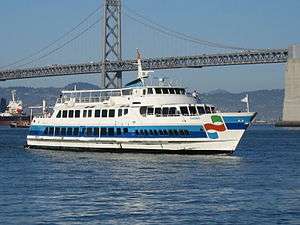 |
San Francisco and Marin County | 7,400[5] | Yes | 3 | 4 | Amtrak, BART, Muni Metro, Muni |
| San Francisco Bay Ferry | |
San Francisco, Alameda County, Contra Costa County, and Solano County | 7,500[5] | Yes | 4 | 9 | AC Transit, Muni Metro, Muni, BART |
Bike Sharing
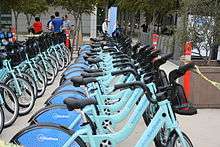
Bay Area Bike Share is a regional public bicycle sharing system that serves the cities of San Francisco, Redwood City, Palo Alto, Mountain View, and San Jose, along the Caltrain corridor.
The bicycles are available 24 hours a day, seven days a week to anyone who purchases a membership, with three options, annual fee of US$88, US$22 for three days or US$9 for 24 hours. Any rider may take unlimited trips of up to 30 minutes, as measured from the time the bike is withdrawn from a dock to the time it is returned. Bikes can be picked up at any of the stations using a key fob or electronic code, and dropping them off at any station. Longer trips incur additional fees starting at US$4 for the first additional half-hour, since the idea of bike sharing is to make bicycles available for short trips.[13] A replacement fee of $1,200 is charged if a rented bike is lost.[13]
Freeways and highways
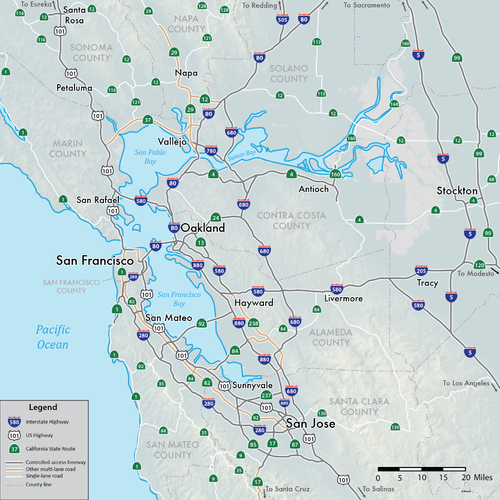
The Bay Area possesses an extensive freeway and highway system.
Trans-bay crossings
| |
Interstate 80 San Francisco - Oakland Bay Bridge |
The western terminus of I-80 is located in San Francisco as James Lick Skyway (Bayshore Freeway), just west of the San Francisco–Oakland Bay Bridge. The interstate continues to the east over the bridge, connecting to Oakland and the north coast of the East Bay as the Eastshore Freeway, and then on to Sacramento, Reno, and New Jersey. |
| |
Interstate 580 Richmond - San Rafael Bridge |
This spur route's western terminus is in Marin County. The Interstate crosses the San Pablo Bay over the Richmond-San Rafael Bridge, goes through Richmond as the John T. Knox Freeway, passes through Oakland as the MacArthur Freeway, then continues to Livermore, through the Altamont Pass to Tracy, where it intersects with Interstate 5, thus providing a link with Southern California. |
| |
Route 92 San Mateo - Hayward Bridge |
SR 92's western terminus is in Half Moon Bay. The two-lane highway crosses the Santa Cruz Mountains, connecting to Interstate 280 and U.S. Route 101 as the J. Arthur Younger Freeway, becoming a freeway as it passes through San Mateo before crossing the San Mateo-Hayward Bridge to Hayward as Jackson Street. |
| |
Route 84 Dumbarton Bridge |
SR 84 begins at Route 1 (at the Pacific Coast) near San Gregorio State Beach, and crosses the Santa Cruz Mountains on a scenic route between La Honda and Woodside as Woodside Road. It then crosses the Bay over the Dumbarton Bridge from Redwood City to Newark. The route then passes through Fremont as Thornton Avenue and Peralta Boulevard, continuing as Niles Canyon Road to Sunol and Livermore as Vallecitos Road and Isabel Avenue, terminating at Interstate 580 as Airway Boulevard. |
The Peninsula to the South Bay
| |
Interstate 280 Southern, Junipero Serra, & Sinclair Freeways Highway 101 Bayshore & South Valley Freeways |
Eight-lane and, in some parts, 10-lane freeways connecting San Francisco to San Jose through the Peninsula. Highway 101 continues south to Gilroy and Salinas, California, before continuing to Los Angeles. For most of its route I-280 runs along the foothills of the Santa Cruz Mountains, and is very scenic, while 101 is highly urban. |
| |
Route 1 Cabrillo Highway Route 35 Skyline Boulevard |
Two-lane highways also traveling down the Peninsula, SR 1 along the Pacific coast, and SR 35 near the ridge of the Santa Cruz Mountains. SR 1 as Cabrillo Highway connects to Half Moon Bay, Santa Cruz, and Monterey, before continuing to Los Angeles. |
| |
Route 9 Route 17 |
Highways through the Santa Cruz Mountains, connecting the South Bay to Santa Cruz. Part of SR 17 in San Jose is an 8 lane freeway. |
| |
Route 85 West Valley Freeway Route 237 Southbay Freeway |
Six-lane freeways connecting the west Santa Clara Valley to the east Santa Clara Valley, bypassing Downtown San Jose. |
| |
Route 87 Guadalupe Freeway |
North-south six-lane freeway entirely in San Jose, connecting San Jose International Airport, Downtown to the Almaden Valley. (formerly the Guadalupe Parkway) |
| |
Route 152 | Two-lane highway from Watsonville, crosses the Santa Cruz Mountains to Gilroy, then crosses the Diablo Range through Pacheco Pass to I-5 near Los Banos. |
| |
Route 156 | Two-lane highway connecting the Monterey Peninsula from Castroville to northern San Benito County and Route 152. |
| |
Route 82 El Camino Real |
Highway running from San Jose to Interstate 280 in San Francisco. It is designated a State Route, although it is more similar to an inner-city boulevard, and contains either 2, 4, or 6 lanes. It runs from Daly City in the north through the Peninsula and beyond. |
The freeway system in Santa Clara county is augmented by its expressway system of county routes.
North Bay
| |
Highway 101 Redwood Highway Route 1 Shoreline Highway |
Continue north of San Francisco, crossing the Golden Gate Bridge and connecting San Francisco to Marin and Sonoma counties, and eventually to Oregon. They are concurrent between the Golden Gate Bridge and Marin City |
| |
Interstate 505 | This interstate highway provides a direct link from Interstate 80 in Vacaville in Solano County to I-5, bypassing Sacramento. |
| |
Route 29 | Four-lane expressway connecting Interstate 80 in Vallejo in Solano County as Sonoma Boulevard to the towns of American Canyon and Napa. North of Napa, SR 29 is a two-lane rural highway through the towns of the Napa Valley, California's Wine Country, to Clear Lake. |
| |
Route 37 | Four- and two-lane expressway connecting US 101 in Novato with Interstate 80 in Vallejo, along the northern shore of San Pablo Bay. |
| |
Route 12 Sonoma Highway |
A highway connecting Santa Rosa with suburbs to the west and Interstate 80 through Sonoma and Napa to the east. |
East Bay
| |
Interstates 680 Sinclair Freeway Interstate 880 Nimitz Freeway |
Two interstate highways that travel up the East Bay from San Jose, 880 close to the bay to Oakland and 680 inland from San Jose north through Fremont, Pleasanton and Concord; then crosses the Benicia-Martinez Bridge and ends at Interstate 80 in Fairfield. |
| |
Interstate 980 Grove Shafter Freeway Route 24 Grover Shafter Freeway |
A freeway entirely in Downtown Oakland and begins at Interstate 880 and travels north to become Route 24 at Interstate 580. The freeway continues north as SR 24, which is a state highway that begins at Interstate 580 in Oakland and travels east through the Caldecott Tunnel to Interstate 680 in Walnut Creek. |
| |
Interstate 205 | This interstate highway's western terminus is at Interstate 580 in Alameda County just west of the San Joaquin County line. I-205 heads east through Tracy to I-5, providing access from the Bay Area to Stockton and the northern San Joaquin Valley. |
| |
Route 13 Warren Freeway |
A highway entirely in the Oakland Hills and travels north from Interstate 580 to Route 24, where the freeway portion ends. Beyond SR 24, SR 13 is Berkeley's Ashby Avenue. |
| |
Interstate 238 Route 238 Mission Boulevard |
An arterial from Fremont to Hayward, along the base of the hills, then becomes a freeway near Oakland. |
| |
Route 4 John Muir Parkway California Delta Highway |
Western terminus at Interstate 80 in Hercules, travels east through Martinez, Pittsburg, and Antioch, where the freeway portion ends. The highway continues to Brentwood and east to Stockton. |
Named interchanges
The Alemany Maze is the interchange between the James Lick Freeway (U.S. Route 101) and Interstate 280.
The MacArthur Maze is the interchange between the Eastshore Freeway, Nimitz Freeway, and MacArthur Freeway at the east end of the Bay Bridge.
The Joe Colla Interchange is the interchange between US 101, I-280, and I-680. Both I-280 and I-680's southern termini is located as this interchange.[14]
San Francisco streets
Due to its unique geography, and the freeway revolts of the late 1950s,[15] San Francisco is one of the few American cities with arterial thoroughfares instead of having numerous highways within the city.

Interstate 80 begins at the approach to the Bay Bridge and is the only direct automobile link to the East Bay. U.S. Route 101 connects to the western terminus of Interstate 80 and provides access to the south of the city along San Francisco Bay toward Silicon Valley. Northward, the routing for U.S. 101 uses arterial streets Mission Street (northbound) and South Van Ness Avenue (southbound), Van Ness Avenue, Lombard Street, Richardson Avenue, and Doyle Drive to connect to the Golden Gate Bridge, the only direct automobile link to Marin County and the North Bay.

State Route 1 also enters San Francisco from the north via the Golden Gate Bridge, but turns south away from the routing of U.S. 101, first onto Park Presidio Blvd through Golden Gate Park, and then bisecting the west side of the city as the 19th Avenue arterial thoroughfare, joining with Interstate 280 at the city's southern border. Interstate 280 continues south from San Francisco. Interstate 280 also turns to the east along the southern edge of the city, terminating just south of the Bay Bridge in the South of Market neighborhood. After the 1989 Loma Prieta earthquake, city leaders decided to demolish the Embarcadero Freeway, and a portion of the Central Freeway, converting them into street-level boulevards.[15]
State Route 35 enters the city from the south as Skyline Boulevard, following city streets until it terminates at its intersection with Highway 1. State Route 82 enters San Francisco from the south as Mission Street, following the path of the historic El Camino Real and terminating shortly thereafter at its junction with 280. Major east–west thoroughfares include Geary Boulevard, the Lincoln Way/Fell Street corridor, and Market Street/Portola Drive.
The Western Terminus of the historic transcontinental Lincoln Highway, the first road across America, is in San Francisco's Lincoln Park.
Bridges

Due to the central location of the San Francisco Bay, eight toll bridges cross the Bay or Bay tributaries. Each of the bridges collect separate tolls, and all of them accept payment through FasTrak, an electronic toll collection system used in the state of California. Seven of these eight bridges are owned directly by the State of California, while the Golden Gate Bridge is owned and operated by the Golden Gate Bridge, Highway and Transportation District.[16]
| Bridge Name | Picture | Connects | Length |
|---|---|---|---|
| Antioch Bridge |  |
Antioch in Contra Costa County with Sacramento County | 1.8 mi (2.9 km) |
| Benicia-Martinez Bridge |  |
Solano County with Contra Costa County | 1.7 mi (2.7 km) |
| Carquinez Bridge |  |
Vallejo in Solano County with Crockett in Contra Costa County | 0.66 mi (1.06 km) |
| Dumbarton Bridge |  |
Menlo Park in San Mateo County with Fremont in Alameda County | 1.63 mi (2.62 km) |
| Golden Gate Bridge |  |
San Francisco with Marin County | 1.7 mi (2.7 km) |
| Richmond-San Rafael Bridge |  |
Richmond in Contra Costa County with San Rafael in Marin County | 5.5 mi (8.9 km) |
| San Francisco–Oakland Bay Bridge |  |
San Francisco with Oakland, California and the East Bay | 4.46 mi (7.18 km) |
| San Mateo-Hayward Bridge |  |
San Francisco Peninsula with the East Bay | 7 mi (11 km) |
Seaports
The Port of San Francisco was once the largest and busiest seaport on the West Coast. It featured rows of piers perpendicular to the shore, where cargo from the moored ships was handled by cranes and manual labor and transported to nearby warehouses. The port handled cargo to and from trans-Pacific and Atlantic destinations, and was the West Coast center of the lumber trade. The 1934 West Coast Longshore Strike, an important episode in the history of the American labor movement, brought most ports to a standstill. The advent of container shipping made pier-based ports obsolete, and most commercial berths moved to the Port of Oakland and Port of Richmond. A few active berths specializing in break bulk cargo remain alongside the Islais Creek Channel.
The port currently uses Pier 35 to handle the 60–80 cruise ship calls and 200,000 passengers that come to San Francisco.[17] Itineraries from San Francisco usually include round trip cruises to Alaska and Mexico. The new James R. Herman Cruise Terminal Project at Pier 27 is scheduled to open 2014 as a replacement. The existing primary terminal at Pier 35 has neither the sufficient capacity to allow for the increasing length and passenger capacity of new cruise ships nor the amenities needed for an international cruise terminal.[18]
On March 16, 2013, Princess Cruises Grand Princess became the first ship to home port in San Francisco year round. The ship offers cruises to Alaska, California Coasts, Hawaii, and Mexico. Grand Princess will be stationed in San Francisco until April 2014. Princess will also operate other ships during the summer of 2014, making it the only cruise line home porting year round in San Francisco.[19]
See also
References
- ↑ "Missed Opportunity: Transit and Jobs in Metropolitan America (San Francisco)". Brookings Institution. Retrieved January 8, 2014.
- ↑ "Missed Opportunity: Transit and Jobs in Metropolitan America (San Jose)". Brookings Institution. Retrieved January 8, 2014.
- ↑ "Access Across America: Transit 2014". University of Minnesota. Retrieved October 14, 2014.
- ↑ "SJC Named Second Fastest Growing Medium Hub Airport in US for 2013". Retrieved 14 September 2014.
- 1 2 3 4 5 6 7 8 9 10 11 12 13 14 "APTA Transit Ridership Report - First Quarter 2016" (PDF). American Public Transportation Association (APTA). 19 May 2016. Retrieved 2016-10-25.
- ↑ "TEP Route Data & Proposed Changes". San Francisco Municipal Transportation Agency (SFMTA). 2013. Retrieved 2014-04-08.
- ↑ "BoltBus to launch Bay Area-Los Angeles service". Retrieved November 6, 2013.
- ↑ "Project Overview – Regional Transit". Transbay Transit Center. Archived from the original on December 13, 2006. Retrieved July 25, 2010.
- ↑ "Megabus.Com Expands Service To/From Los Angeles, San Francisco And Six Cities". Retrieved March 26, 2013.
- ↑ "AIBRA - Find a Station". Retrieved May 2, 2015.
- ↑ CCCTA - Operating & Scheduling Committee: Fixed-Route Operating Report for May 2010
- ↑ "Golden Gate Transit: Research Library". Retrieved 14 September 2014.
- 1 2 CBS San Francisco (2013-08-29). "Bike Share Program Launched In 5 Bay Area Cities". CBS 5 KPIX. Retrieved 2013-09-14.
- ↑ Rodriguez, Joe (January 9, 2016). "San Jose's Infamous Monument to Nowhere Freeway Interchange Finally Named after Joe Colla". San Jose Mercury News. Retrieved April 6, 2016.
- 1 2 Gordon, Rachel (September 8, 2005). "Boulevard of dreams, the premiere". San Francisco Chronicle. Hearst Communications. p. B-1. Retrieved June 16, 2008.
- ↑ "Bay Area FasTrak - Agencies and Partners". Bay Area Toll Authority.
- ↑ "SFPort – Cruises". Retrieved March 16, 2013.
- ↑ "SFPort – James R. Herman Cruise Terminal Project at Pier 27". Retrieved March 16, 2013.
- ↑ Engle, Jane (April 15, 2013). "LA Times – Cruises: The Grand Princess finds a home in San Francisco". Los Angeles Times. Retrieved April 22, 2013.
External links
- Bay Area Shuttles directory
- Interstate-Guide.com
- West Coast AA Roads (San Francisco Bay Areas)
- Live Toll Prices for San Francisco Bay Area Bridges
